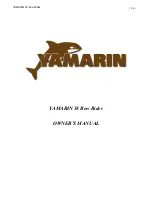
225 Weekender
®
1.3
S
ECTION
1 • S
AFETY
turns cherry red. Because carbon monoxide gas
(CO) is odorless, colorless and tasteless, it is
unlikely to be noticed until a person is overcome.
Dangerous concentrations of carbon monoxide will
be present if:
•
the engine and/or generator exhaust systems
leak;
•
insufficient fresh air is circulating where people
are present; and
•
fumes move from the rear of the boat into the
cockpit and cabin area.
Figure 1.4.1 gives examples of boat operating
conditions that can lead to high concentrations of
carbon monoxide gas.
To minimize the danger of CO accumulation when
the engine and/or generator are running, or using
burning fuel applications.
•
Be sure to have sufficient ventilation when using
canvas or window-type side curtains when
underway, anchored, moored or docked.
•
If the convertible top is installed, operate with
the forward hatch open and leave cabin door
open.
•
Operate all burning fuel appliances, such as
charcoal, propane, LPG, CNG or alcohol
cooking devices in areas where fresh air can
circulate. Do not use such devices where there
is no noticeable air movement, especially in the
cabin, when anchored, moored or docked.
Even in rainy cold weather ventilation must be
maintained to avoid Carbon Monoxide poisoning. You
will get wet and/or cold.
!
DANGER
Sleeping on boat requires a operating Carbon
Monoxide detection system in each sleeping location.
!
DANGER
•
Do not idle engine without moving boat for more
than 15 minutes at a time.
•
Inspect the exhaust system regularly. (See
Section 8, Required Inspection, Service and
Maintenance.
If CO poisoning is suspected, have the victim breath
fresh air deeply. If breathing stops, resuscitate. A
victim often revives, then relapses because organs
are damaged by lack of oxygen. Seek immediate
medical attention.
A
. C
ARBON
M
ONOXIDE
M
ONITOR
You boat has carbon monoxide (CO) monitors
mounted throughout the boat . The CO monitor is
an electronic instrument that detects CO. When
there is a buildup of CO, the monitor will alert the
occupants by a flashing DANGER light and alarm.
The CO monitor is wired through a breaker on the
DC distribution panel.
It is extremely important that you become totally
familiar with your CO monitor and its functions.
Read and understand the CO monitor information
and operating instructions located in your Owner’s
Manual Packet.
5. L
IFESAVING
E
QUIPMENT
Even strong swimmers can tire quickly in the water
and drown due to exhaustion, hypothermia, or both.
The buoyancy provided by a personal flotation
device (PFD) will allow the person who has fallen
overboard to remain afloat with far less effort and
heat loss, extending survival time necessary to find
and retrieve them.
Boat operators are required to carry one wearable
personal flotation device (Type I,II,III or V) for every
person on board. Boats must also have at least one
throwable device (Type IV).
The law requires that PFD’s must be readily
accessible, if not worn. “Readily accessible” means
removed from storage bags and unbuckled. But,
Summary of Contents for 225 Weekender
Page 1: ...225 Weekender Owner s Manual Part Number MRP1803643 Sea Ray Owner s Manual...
Page 2: ......
Page 4: ...225 Weekender...
Page 48: ...225 Weekender 3 8 SECTION 3 USING YOUR BOAT THIS PAGE LEFT INTENTIONALLY BLANK...
Page 54: ...225 Weekender 4 6 SECTION 4 BILGE UNDERWATER GEAR THIS PAGE LEFT INTENTIONALLY BLANK...
Page 60: ...225 Weekender 5 6 SECTION 5 FUEL SYSTEM THIS PAGE LEFT INTENTIONALLY BLANK...
Page 96: ...225 Weekender 9 4 SECTION 9 CARE REFINISHING THIS PAGE LEFT INTENTIONALLY BLANK...














































